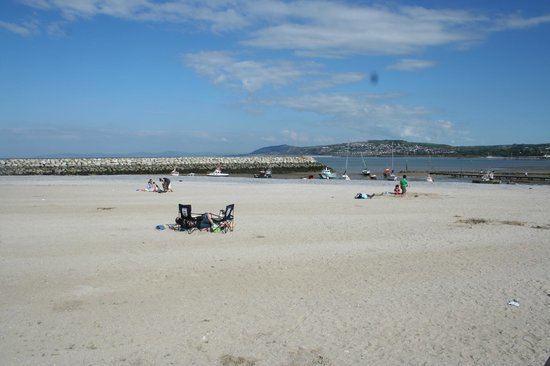Population 7,593 (2011) Community Rhos-on-Sea Country Wales Local time Wednesday 1:37 PM | OS grid reference SH842805 Sovereign state United Kingdom Dialling code 01492 University Coleg Llandrillo Cymru | |
 | ||
Weather 14°C, Wind S at 18 km/h, 86% Humidity | ||
Plas rhos house 5 star accommodation rhos on sea north wales
Rhos-on-Sea (Welsh: Llandrillo-yn-Rhos), also known as Rhos or Llandrillo, is a seaside resort , community and electoral ward in Conwy County Borough, Wales. The population was 7,110 in 2001, increasing to 7,593 at the 2011 census. It adjoins Colwyn Bay. It is named after the Welsh kingdom of Rhos established there in late Roman times as a sub-kingdom of Gwynedd, and later became a cantref (hundred).
Contents
- Plas rhos house 5 star accommodation rhos on sea north wales
- Map of Rhos on Sea UK
- Bryn Euryn and Llys Euryn
- St Trillos Chapel
- Rhos Fynach
- Madog and claims for the discovery of America
- Other features
- Trams
- References
Map of Rhos on Sea, UK
Bryn Euryn and Llys Euryn
Bryn Euryn is a hill overlooking Rhos-on-Sea on which there are the remains of a hillfort called Dinerth, the 'fort of the bear', and a limestone quarry. Ednyfed Fychan, 13th century seneschal to Llywelyn the Great and ancestor to the House of Tudor was granted the land and built a castle on the hill, of which all traces have disappeared, and a manor, Llys Euryn of which the ruins of its 15th-century reconstruction can be seen today.
St Trillo's Chapel
The 6th century St Trillo's Chapel (Welsh: Capel Sant Trillo), which was the mother church of a large parish which included places as far apart as Eglwysbach and Eglwys Rhos (Llan Rhos).
The chapel by the sea is on the site of a pre-Christian, sacred holy well; the altar is built directly over the pure water of the well. Saint Trillo, the son of Ithel Hael from Llydaw (Snowdonia) also founded a church at Llandrillo in Denbighshire. Trillo's brother Tygai (Llandygai) founded a church near Penrhyn, Bangor; their sister Llechid founded a church (Llanllechid) in the uplands above Penrhyn.
Llandrillo yn Rhos Church [2] was built on the site of Ednyfed Fychan's private chapel and incorporates what was his tombstone, the history of this church goes back to the 13th century, but having been rebuilt over the centuries, the oldest parts of the present church are 15th century. A major restoration was carried out in 1857 and was criticised by some for amounting to 'vandalism', in particular the destruction of an ancient stained glass window. Nevertheless, it remains one of the most important historic buildings in North Wales.
The stone lych-gate was built in 1677 and is one of the oldest in the district, the sundial is from the early 18th century.
The graveyard here contains the grave of Harold Lowe, an officer on the RMS Titanic. He was widely regarded as a hero, helping many to safety with cool nerve and bravery. It also contains war graves of eight service personnel, two of World War I and six of World War II.
Rhos Fynach
In 1186 Llywelyn the Great permitted the establishment of the Cistercian Aberconwy Abbey, and the monks built a fishing weir on the sea shore below Bryn Euryn. The place became known as Rhos Fynach, heath of the monks. In a charter of 1230, Llywelyn sanctioned the purchase by Ednyfed Fychan of land at Rhos Fynach and in 1289, the abbey moved to Maenan (becoming Maenan Abbey), and the weir was ceded to Ednyfed's estate. Eventually Rhos Fynach and the weir came into the hands of Robert Dudley, Earl of Leicester, who in 1575 granted it to a Captain Morgan ap John ap David, a privateer, for services rendered against the enemies of Queen Elizabeth I at sea. (This is not the famous pirate of the Caribbean Captain Henry Morgan who lived in the century following).
The weir continued to provide a prosperous livelihood through to the early 20th century: during a single night in 1850, 35,000 herring were caught, and 10 tons of mackerel were removed in one tide as late as 1907. Because such weirs decimated inshore fish stocks, Parliament banned them in 1861 unless it could be shown they pre-dated the Magna Carta, which the then owners, the Parry Evans family, were able to prove. Their estate included Rhos Fynach house, also known as Rhos Farm, on the Promenade near St Trillo's Chapel. The house is now a pub and restaurant. Its date of construction is not known for sure, but it is considered to have been started by the Cistercians before the Dissolution of the Monasteries.
The fishing weir fell into disuse during World War I and most traces have disappeared. Trial excavation of the site in 1993 recorded constructions carbon 14-dated between 1500 and 1660.
Madog and claims for the discovery of America
Perhaps Rhos-on-Sea's greatest claim to fame is that, according to legend, Madog ap Owain Gwynedd, a Welsh prince of Gwynedd, sailed from here in 1170 and discovered America, over three hundred years before Christopher Columbus's famous voyage in 1492. This event is recorded by a plaque on one of the properties on the sea-front. This property is called "Odstone" at no. 179, Marine Drive which, as of June 2012, has become neglected.
Other features
Trams
The Llandudno and Colwyn Bay Electric Railway operated an electric tramway service between Llandudno and Rhos-on-Sea from 1907 and extended to Colwyn Bay in 1908. The service closed in 1956.
